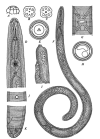|
Length, female: 1.3-1.7 mm; length, male: not found
Female:
-
Body cylindroid,
slightly arcuate when relaxed by gentle heat.
-
Lip region distinctly offset,
with 3 annules marked by 6-9 longitudinal striae. In face view 6
lips are seen with 1 papilla on each submedian lip.
-
Cephalic framework prominent
with 6 segments, the ventral and dorsal ones bifurcated.
-
Spear, massive, 41-45 um long
with tulip-shaped knobs.
-
Outlet of dorsal esophageal
glands 4-6 um. from spear.
-
Amphids slitlike.
-
Cuticle annules, about 1um
apart, continous around body except on tail
-
Lateral field apparently
absent
-
Hemizonid, 3-9 um posterior
to excretory pore.
-
Scutella ovate, varied
locations but always anterior to vulva.
-
Median bulb ovate with
prominent valvular apparatus.
-
Isthmus short.
-
Esophageal glands,
overlapping intestine dorsolaterally, containing 5 prominent
nuclei.
-
Vulva, transverse, slit-like,
equatorial.
-
Didelphic, amphidelphic.
Oocytes in single file except for a short region of multiplication
close to distal end.
-
No spermathecae.
-
Tail terminus broadly
rounded, annulated.
Male: Not found
Distinguishing characteristics:
Only three cephalic annules and five esophageal gland nuclei.
Ref: Ramirez, 1964
Reported median body size for this species (Length mm; width micrometers; weight micrograms) - Click:
|

Hoplolaimus puertoricensis Female
A: lip region; B: face view; C: cephalic framework; D: anterior body;
E: cross-section, isthmus region; F: whole body; G: vulva, ventral
view; H: cross-section posterior body; I: esophageal glands; J:
scutellum; K: tail |